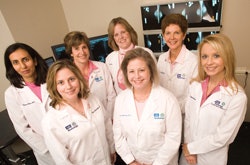Few diagnoses strike more terror in the hearts of women than that of breast cancer.

Advanced breast imaging modalities can provide specific clinical information designed to improve the detection and treatment of breast cancer, from the anatomic clarity of MRI to the functional activity revealed through nuclear breast imaging. Each modality has a unique role to play in managing patients with breast cancer.
But the proliferation of new technology can create challenges for today's breast care specialists, who must understand the relative strengths and weaknesses of each imaging approach and decide which patients should get what modality. Two comprehensive breast centers share their experiences in integrating and managing some of the most advanced technologies available for breast imaging and diagnosis.
Imaging and dense breast tissue
Mammography is the screening modality of choice for women who meet the BI-RADS classification of fatty breast tissue or scattered fibroglandular density. More than 40% of the millions of women undergoing mammography have dense breasts; for these women, another technique must be used.
Ultrasound is the initial tool of choice for targeted use to refine diagnosis of a mass detected on mammography, or for specific clinical indications such as pain or a lump detected by physical examination, according to Robin Shermis, MD, medical director of the Toledo Hospital Breast Care Center in Ohio. He considers the use of ultrasound for first-line screening to be problematic because the modality's specificity in detecting cancerous lesions is less than ideal.
MRI is useful for diagnostic work and preoperative staging, as well as in instances when a woman has a complex, dense mammogram that is difficult to determine the nature of the images or has equivocal findings that are hard to biopsy, Shermis explained. For women who meet the genetic criteria or have other personal risk factors, such as family history, that place them above a 20% risk of developing breast cancer, the center performs MRI scans as a form of tailored breast imaging. "I tell my patients with dense breasts that nothing can hide from an MRI," Shermis said.
Some centers have employed positron emission mammography (PEM) to further characterize lesions, monitor treatment response, or look for local recurrences or metastases. Essentially a breast-specific PET scan that employs FDG as the radiotracer, the technique is not usually used for first-line imaging, but it offers greater specificity than MRI and reduces false-positive results.
Two other nuclear breast imaging modalities, both of which use the technetium-99m (Tc-99m) sestamibi radiopharmaceutical, are breast-specific gamma imaging (BSGI) and molecular breast imaging (MBI) (see "MBI casts wider net for improved breast cancer diagnosis").
How are the new technologies likely to be used in clinical practice, and to which patients should they be directed? A look at two cutting-edge breast care facilities can provide some answers.
Anatomy of a new comprehensive breast center
Baptist Health of Northeast Florida in Jacksonville will open its Margaret and Robert Hill Breast Center in October 2010. The 24,000-sq-ft outpatient imaging center will serve as the cornerstone for Baptist Health's comprehensive approach to women with breast cancer in the community, and it's been designed to provide all necessary services for breast cancer management under one roof, according to Christine Granfield, MD, medical director of breast services at Baptist Health and a partner in the radiology practice Mori, Bean & Brooks of Jacksonville.
The center was designed to feature services and patient amenities to help reduce the stress of breast cancer diagnosis. This holistic approach to care will include massage therapists, yoga classes, and a special room to provide entertainment for children while their mothers receive treatment. Instead of a television blaring in the corner, the center will include a soothing architectural water feature.
In addition to providing diagnostic imaging, the center will have an adjoining floor dedicated to breast surgery, with radiation therapy and oncologic treatment available at the adjoining cancer center, Granfield said.

Currently, Baptist Health of Northeast Florida performs more than 60,000 exams a year throughout its system. Half of the exams are performed at its current 7,000-sq-ft center, which will be replaced by the new facility, and the remainder of the screening tests are performed at three outlying sister hospitals.
The new Hill Breast Center will feature an entire floor devoted to screening and also a diagnostic floor with five Senographe full-field digital mammography (FFDM) systems from GE Healthcare of Chalfont St. Giles, U.K.; six GE Logiq E9 ultrasound units; two stereotactic biopsy units; a LumaGem MBI system from Gamma Medica of Northridge, CA; and a dedicated GE Discovery MR450 MRI system with a breast biopsy table from Sentinelle Medical of Toronto in the basement.
Hill Breast Center is installing the MBI unit to help the facility deal with the diagnostic workup of a specific segment of the population: women with dense breasts who are at higher risk of breast cancer, but who would not be directed to breast MRI because they don't meet the American Cancer Society's (ACS) criteria of a greater than 20% to 25% lifetime risk of breast cancer to quality for the modality.
Baptist Health has had experience with a PEM camera, but Granfield sees advantages to MBI that are prompting the facility to switch. The cost of an MBI system is about two-thirds that of a PEM unit; while reimbursement for MBI is lower ($1,100 for PEM versus approximately $450 for MBI), the price of the Tc-99m sestamibi radiopharmaceutical used by MBI is less than that of FDG used in PEM.
MBI also has workflow advantages. Unlike PEM, patients don't have to fast, Granfield said. She also believes that PEM reads are more complicated than MBI scans, in which radiologists basically only have to look for "hot spots" on images.
"That's important these days because you're trying to get through screening studies," Granfield said. "You want to be able to help those patients."
Granfield and colleagues will use the MBI system for diagnostic use and for screening patients with dense breasts and a family history of breast cancer, but who have less than a 20% lifetime risk of breast cancer, making them unsuitable for screening MRI per ACS guidelines. Also promising is work being conducted at the Mayo Clinic in Rochester, MN, on reducing the radiation dose of MBI (see "Radiation in women's imaging: Are we scared yet?").
Equipment + expert staff = total approach
Radiologists at another advanced breast care center, at Toledo Hospital, believe it's impossible to overstate the importance of having well-educated and specialized technologists to perform imaging studies on the best equipment available, according to Shermis.
He considers digital mammography to be the centerpiece of Toledo's screening program, but ultrasound, MR, and MBI offer comprehensive imaging options. It's key that each member of the staff understands the best uses for each modality, he said.

Shermis described the imaging path for a typical woman who qualifies for an MRI, such as an individual with dense breast tissue who has a lifetime risk of at least 20% for developing breast cancer due to family history and/or personal risk factors. If a breast MRI indicates a suspicious area, the radiologist discusses the results with the patient, and he or she orders an ultrasound followed by ultrasound-guided biopsy of the suspicious area.
However, MRI is expensive and unavailable for women who don't qualify on the basis of risk. To address those needs, Toledo Hospital is acquiring the LumaGem MBI scanner in a dual-head configuration.
MRI is more expensive to perform than MBI, given the purchase price and costs of site preparation, installation, and maintenance, Shermis continued. Not only does the molecular exam require fewer resources, it also provides specificity in identifying cancerous tissue. If a patient has an equivocal mammogram, MRI shows many nondefined small areas, and if the lesion is not amenable to ultrasound, the molecular study can be used to determine whether the lesion is malignant.
Having multiple advanced imaging modalities available in-house means all follow-up studies are completed in one visit, which reduces opportunities for unnecessary delays in completing diagnosis and developing a treatment plan, Shermis explained.
The bottom line for all of the imaging is the necessity of integrating all modalities, with both dedicated technologists and specialized radiologists performing and interpreting the studies.
Reimbursement for some of the newer technologies such as MBI requires expert and diligent precertification activities, as well as many conversations with the medical directors of insurance plans, Shermis cautioned (see "MBI could help breast centers caught in economic squeeze").
Economic realities produce challenges
The ideal management of women with breast cancer involves the integrated, comprehensive approaches described above, but the costs associated with care may ultimately determine which patients have access to the different advanced breast imaging techniques that are available.
While Medicare administrators and third-party payors are closely watching the costs incurred in the use of advanced imaging technologies, Shermis believes that when used wisely they can be cost-effective. He concluded with a reminder that when dealing with the overall expense associated with breast cancer, detection and diagnosis only accounts for 6% of the costs; the remainder is required for treatment.
"You have to hope that if you spend more on detection and diagnosis, you'll end up spending less on treatment because hopefully you'll find lesions that are smaller," Shermis said. "This will improve outcomes as well as reduce costs."
By Cheryl Hall Harris
AuntMinnie.com contributing writer
September 14, 2010
Copyright © 2010 AuntMinnie.com



















